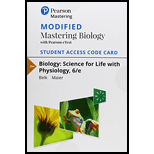
EP BIOLOGY:SCIENCE F/LIFE...-MOD.ACCESS
6th Edition
ISBN: 9780134839530
Author: BELK
Publisher: PEARSON CO
expand_more
expand_more
format_list_bulleted
Concept explainers
Question
Chapter 21, Problem 10LTB
Summary Introduction
Introduction:
The second line of defense can be defined as the nonspecific resistance that eliminates the pathogenic invaders in a usual way. If the pathogens pass the first line of defense such as through a cut in the skin, the infection progresses. In that case, the second line of defense plays its role to protect the body.
Expert Solution & Answer
Want to see the full answer?
Check out a sample textbook solution
Students have asked these similar questions
Which of the following is not involved in first line defense?
a-Mucus membranes
b-Saliva
c-Sweat
d-Antibodies
e-Cilia
Which of the following is NOT one of the major functions of T lymphocytes (T cells)?
activating the immune system
binding to antigens presented by MHC proteins
production of antibodies
forming memory cells to more rapidly respond to future infections by the same pathogen
attacking our own cells that are infected with a virus or cancerous
Which of the following is NOT part of the body's third line of defense?
Antibodies
Cytotoxic T-lymphocytes
Neutrophils
B-lymphocytes
Chapter 21 Solutions
EP BIOLOGY:SCIENCE F/LIFE...-MOD.ACCESS
Knowledge Booster
Learn more about
Need a deep-dive on the concept behind this application? Look no further. Learn more about this topic, biology and related others by exploring similar questions and additional content below.Similar questions
- Which of the following types of immunity is responsible for preventing pathogens from entering the cell? antibody-mediated (Humoral) immunity OOOO sarcoplasmic immunity pathogenic immunity cell-mediated immunityarrow_forwardWhich of the following is a mechanism by which antibodies help rid the body of invading microbes? Agglutination whereby the bacteria are clumped together. Identifying viruses for elimination by NK cells Non-antibody dependent activation of complement Autoimmune diseasearrow_forwardWhat distinguishes the innate defense system from the adaptive defense system.arrow_forward
- Which of the following is mismatched? Epitope - Specific area on an antigen that interacts with antibody Acquired (or Adaptive) Immunity - innate, nonspecific resistance to infection; present at birth Antigen - Substance that provokes a specific immune response Susceptibility - Lack of resistance to a disease Antibody - Protein made in response to an antigen which can specifically bind to that antigenarrow_forwardWhich line(s) of defense is(are) called innate? O First O Third Secondarrow_forwardWhich pathway of complement activation is depicted in this figure?arrow_forward
- Epithelial tissue covers surfaces and lines cavities. This is the ___ line of defense. mechanical antibody-antigen physical chemicalarrow_forwardWhich of the following statements is true of acquired immunity? It does not involve experience and its forms include phagocytosis and inflammation. Acquired immune responses take longer to initiate than natural immune responses. An effective immune response occurs even before prior exposure to a particular antigen. It consists of a number of inborn processes that help remove foreign substances from the body.arrow_forwardWhich of the following is a FALSE statement about innate immunity? Natural killer cells are participants in the process It must be primed by the presence of a specific antigen It includes inflammatory responses It may involve the formation of complement protein cascades It includes physical and chemical barriersarrow_forward
- The body’s immune response comprises innate immunity and adaptive immunity. Virulence is the capacity of a pathogen to cause disease BOTH statements are FALSE BOTH statements are TRUE FIRST statement is FALSE; SECOND statement is TRUE FIRST statement is TRUE; SECOND statement is FALSEarrow_forwardWhich of the following is a component of the first line of defense in the innate defense system? T cell activation phagocyte and natural killer cell activation secretion of sweat and sebum onto the epidermis all the above a and barrow_forwardWhich of the following are components of the adaptive immune system that actively fight infection (i.e. is able to inactivate a pathogen)? Select all that apply. Group of answer choices Cytokines Neutrophils T-cells Antibodies Natural killer cells Antigen presenting cellsarrow_forward
arrow_back_ios
SEE MORE QUESTIONS
arrow_forward_ios
Recommended textbooks for you
 Biology 2eBiologyISBN:9781947172517Author:Matthew Douglas, Jung Choi, Mary Ann ClarkPublisher:OpenStax
Biology 2eBiologyISBN:9781947172517Author:Matthew Douglas, Jung Choi, Mary Ann ClarkPublisher:OpenStax

Biology 2e
Biology
ISBN:9781947172517
Author:Matthew Douglas, Jung Choi, Mary Ann Clark
Publisher:OpenStax
Immune System and Immune Response Animation; Author: Medical Sciences Animations;https://www.youtube.com/watch?v=JDdbUBXPKc4;License: Standard YouTube License, CC-BY
Immune response: summary; Author: Dr Bhavsar Biology;https://www.youtube.com/watch?v=ADANgHkX4OY;License: Standard Youtube License